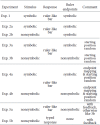Comparing Symbolic and Nonsymbolic Number Lines: Consistent Effects of Notation Across Output Measures
- PMID: 32256903
- PMCID: PMC7121558
- DOI: 10.5709/acp-0241-9
Comparing Symbolic and Nonsymbolic Number Lines: Consistent Effects of Notation Across Output Measures
Abstract
The mental number line (MNL) is a popular metaphor for magnitude representation in numerical cognition. Its shape has frequently been reported as being nonlinear, based on nonlinear response functions in magnitude estimation. We investigated whether this shape reflects a phenomenon of the mapping from stimulus to internal magnitude representation or of the mapping from internal representation to response. In five experiments, participants (total N = 66) viewed stimuli that represented numerical magnitude either in a symbolic notation (i.e., Arabic digits) or in a nonsymbolic notation (i.e., clouds of dots). Participants estimated these magnitudes by either adjusting the position of a mark on a ruler-like response bar (nonsymbolic response) or by typing the corresponding number on a keyboard (symbolic response). Responses to symbolic stimuli were markedly different from responses to nonsymbolic stimuli, in that they were mostly powershaped. We investigated whether the nonlinearity could be explained by effects of previous trials, but such effects were (a) not strong enough to explain the nonlinear responses and (b) existed only between trials of the same input notation, suggesting that the nonlinearity is due to input mappings. Introducing veridical feedback improved the accuracy of responses, thereby showing a calibration based on the feedback. However, this calibration persisted only temporarily, and responses to nonsymbolic stimuli remained nonlinear. Overall, we conclude that the nonlinearity is a phenomenon of the mapping from nonsymbolic input format to internal magnitude representation and that the phenomenon is surprisingly robust to calibration.
Keywords: calibration; nonsymbolic magnitude; number line; numerical cognition.
Copyright: © 2018 University of Economics and Human Sciences in Warsaw.
Figures






Similar articles
-
Symbolic, Nonsymbolic and Conceptual: An Across-Notation Study on the Space Mapping of Numerals.Perception. 2016 Jul;45(7):787-804. doi: 10.1177/0301006616638782. Epub 2016 Mar 23. Perception. 2016. PMID: 27013480
-
Symbolic fractions elicit an analog magnitude representation in school-age children.J Exp Child Psychol. 2020 Jul;195:104844. doi: 10.1016/j.jecp.2020.104844. Epub 2020 Mar 31. J Exp Child Psychol. 2020. PMID: 32244000 Free PMC article.
-
Effects of number magnitude and notation at 7T: separating the neural response to small and large, symbolic and nonsymbolic number.Cereb Cortex. 2014 Aug;24(8):2199-209. doi: 10.1093/cercor/bht074. Epub 2013 Mar 27. Cereb Cortex. 2014. PMID: 23535179
-
Foundations of children's numerical and mathematical skills: the roles of symbolic and nonsymbolic representations of numerical magnitude.Adv Child Dev Behav. 2015;48:93-116. doi: 10.1016/bs.acdb.2014.11.003. Epub 2015 Jan 22. Adv Child Dev Behav. 2015. PMID: 25735942 Review.
-
Are numbers grounded in a general magnitude processing system? A functional neuroimaging meta-analysis.Neuropsychologia. 2017 Oct;105:50-69. doi: 10.1016/j.neuropsychologia.2017.01.019. Epub 2017 Jan 22. Neuropsychologia. 2017. PMID: 28119003 Review.
References
-
- Akaike H. A new look at the statistical model identification. 1974;19:716–723.
-
- Anobile G., Cicchini G. M., Burr D. C. Linear mapping of numbers onto space requires attention. Cognition. 2012;122:454–459. - PubMed
-
- Barth H. C., Paladino A. M. The development of numerical estimation: evidence against a representational shift. Developmental Science. 2011;14:125–135. - PubMed
-
- Burnham K. P., Anderson R. P. Multimodel inference: Understanding AIC and BIC in model selection. . 2004;33:261–304.
LinkOut - more resources
Full Text Sources
